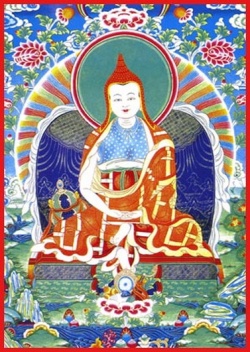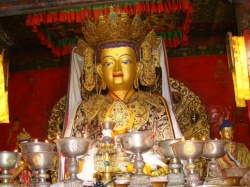Mañjuśrīmitra
Click here to see other articles relating to word Mañjuśrīmitra
Mañjushrimitra (Skt. Mañjuśrīmitra; Tib. འཇམ་དཔལ་བཤེས་གཉེན་, Jampal Shenyen; Wyl. ‘jam dpal bshes gnyen) — one of the early masters of the Dzogchen lineage. He was a disciple of Garab Dorje and the main teacher of Shri Singha.
Manjushrimitra (S): Tibetan: Jampa Shenyen. Buddhist scholar, and possibly a king of Singhala (now Sri Lanka), who is said to have been a student of Garab Dorje, and who was given the Nyingtig teachings both in personal contact and during visionary appearance after his teachers passing.
Manjusrimitra classified the teachings he received and transmitted this Dzogchen material to Sri Singha.
The problem with this story is that it covers a few centuries in time. If Manjushrimitra knew Garab Dorje, he must have lived in the 2nd or 1st century BCE; placing his disciple Sri Singha not much later.
But Sri Singha is also supposed to have had personal contact with Padmasambhava and Vimalamitra (as is also reported in the mid-8th century.
He is famous for arranging the Dzogchen teachings into three classes:
the Mind Class (Tib. སེམས་སྡེ་, sem dé),
Space Class (Tib. ཀློང་སྡེ་, long dé), and
Pith Instruction Class (Tib. མན་ངག་སྡེ་, mengak dé).
His last testament, which he conferred upon Shri Singha before passing into the rainbow body, is called the Six Experiences of Meditation.
Further Reading
- Dudjom Rinpoche, The Nyingma School of Tibetan Buddhism, Its Fundamentals and History, trans. and ed. Gyurme Dorje (Boston: Wisdom, 1991), vol.1 pages 490-494.
- Nyoshul Khenpo, A Marvelous Garland of Rare Gems: Biographies of Masters of Awareness in the Dzogchen Lineage (Junction City: Padma Publications, 2005), pages 38-39.
- Tulku Thondup, Masters of Meditation and Miracles, edited by Harold Talbott (Boston: Shambhala, 1996), pages 59-61.
External Links
Source
Mañjuśrīmitra (fl. 55 CE)(Tibetan: Jampelshenyen, ཇམ་དཔལ་བཤེས་གཉེན་, Wylie: 'Jam-dpal-bshes-gnyen) was an Indian Buddhist scholar, the main student of Garab Dorje and a teacher of Dzogchen.
Nomenclature and etymology
Mañjuśrī-mitra was his ordination-name—before ordination he was named "Siddhi-garbha" and "Samvara-garbha"; and his mother's name was Kuhanā.
Birth and early Life
The exact location of Mañjuśrīmitra's birth is unknown.
Mañjuśrīmitra, the son of an upper class Brahmin from a village to the west of Bodh Gaya, was initially schooled at home.
Later he was a resident at Nalanda University where he became a respected Yogācāra scholar and practitioner.
Works
Many of Mañjuśrīmitra's works deal with a tantric text Mañjuśrīnāmasamgīti.
He was the person who divided the Dzogchen teachings into three series of Semde, Longde and Manngagde.
In the Tibetan Buddhist Vajrayana tradition, Mañjuśrīmitra is held to have transmitted the Dzogchen teachings to Sri Singha.
The "Six Meditation Experiences" (Tibetan: Gomnyam Drukpa) concealed in a jewelled casket was Mañjuśrīmitra's "quintessential testament" to Sri Singha, his principal Disciple.
One of the main works of Mañjuśrīmitra is Gold refined from ore.
Manjushrimitra discusses the Mindstream (Sanskrit: Citta-santana) in the Bodhicittabhavana, a seminal early text of Ati Yoga:
"The Mental-continuum (Citta-santana) is without boundaries or extension;
it is not one thing, nor supported by anything."
In this work, Manjushrimistra counters and tempers the Madhyamaka of Nagarjuna into what developed into the Mindstream Doctrine.
Manjushrimitra makes it clear that intellectualism, philosophy and logic do not lead to realization and that "Those who seek the Truth must turn to direct yogic experience, should they hope to acquire realization."
Vajranatha (2007) contextualises Manjushrimitra and mentions Dzogchen, Chittamatra, Yogachara, Three Turnings of the Wheel of Dharma, and Garab Dorje:
- Moreover, in terms of content, it is quite clear that the early Dzogchen Movement of the eighth and ninth centuries did not teach the Chittamatra Doctrine of the Yogacharins, even though it borrowed some of the terminology of the earlier school.
But it understood these terms in a different manner than did the Yogacharins.
The Precepts of Dzogchen are found in the Dzogchen Tantras of Atiyoga and not in the Mahayana Sutras of the Third Turning of the Wheel of the Dharma, although later Lama scholars in Tibet noticed the existence of certain similarities in terminology between Dzogchen and Chittamatra.
This may be due to the activities of the scholar Manjusrhimitra who wrote a book on Garab Dorje's teaching from the Yogachara perspective.
Source
Manjushrimitra (jam dpal bshes gnyen, pron. Jampal Shenyen).
An Indian master in the Dzogchen lineage and the chief disciple of Garab Dorje.
In his role as a master in the lineage of the Sadhana Section of Mahayoga, he received the transmission of Yamantaka in the form of the Secret Wrathful Manjushri Tantra and other texts.
Manjushrimitra was born in the Magadha district of India and was soon an adept in the general sciences and the conventional topics of Buddhism.
After having become the most eminent among five hundred panditas, he received many teachings and empowerments from Garab Dorje, Lalitavajra, and other masters and reached the unified level of enlightenment, indivisible from Manjushri.
Yamantaka appeared to him in person, conferred empowerment and transmitted the tantras and oral instructions.
Among his chief recipients of this teaching were Hungkara, Padmasambhava, and Hanatela.
There seem to have been several masters with this name, but Guru Tashi Tobgyal in his Ocean of Wondrous Sayings to Delight the Learned Ones views them as being magical emanations of the same master.
Source
The Nyingma Dzogchen lineage began in India with the masters Garab Dorje, Mañjuśrīmitra, and Sri Singha.
Born as an upper class Brahmin west of Bodhgaya and renowned as the most eminent of five hundred panditas and the greatest monk-scholar of Nalanda, Mañjuśrīmitra or Friend of Manjushri is regarded as an incarnation of Manjushri Bodhisattva.
In a vision of Manjushri, he was instructed to go to the Sitavana charnel ground and meet Garab Dorje if he wished to attain enlightenment during his lifetime.
This message did not particularly please him because he was already very accomplished in classical Madhyamaka and Garab Dorje was merely a vagabond saint living with a consort!
Nevertheless with great pomp and a splendid entourage, Manjushrimitra set out for Sitavana, fully expecting to defeat Garab Dorje in debate.
However it turned out to be quite a simple matter for Garab Dorje to prove to him how shallow purely intellectual knowledge is in the face of the direct experience of enlightenment.
This most learned scholar had come like a general to do battle, only to fall, conquered before the invincible insight of a vagabond!
When Mañjuśrīmitra begged Garab Dorje to become his disciple, his entourage of Nalanda scholars abandoned him flat out.
Garab Dorje began Mañjuśrīmitra's re-education by instructing him as follows: "The nature of your own mind-essence is, from the very beginning, none other than buddha.
This mind, in and of itself, is birthless and deathless.
It is simply like the sky.
If the intrinsic truth of the nonduality of all phenomena is understood in its totality, and if this view is merely sustained in faith, without making any kind of effort, then that is how one should practice meditation."
Mañjuśrīmitra stayed with Garab Dorje for seventy-five years during which time the aging guru and disciple traveled about, bringing blessings and wisdom to innumerable beings.
When Garab Dorje attained enlightenment, Mañjuśrīmitra beheld him in the sky in a mass of light.
Then with the sound of a thunderclap, a tiny golden casket descended from the light into the palm of his hand.
Within it he found "The Three Words That Penetrate the Essence" written on a leaf, whereupon his realization became equal to Garab Dorje's.
Thereafter, at the Sosaling charnel ground, Mañjuśrīmitra redacted the 6,400,000 verses of Garab Dorje’s teachings into three categories:
Mind,
Space, and
Pith Instructions.
He recorded the oral transmissions he had received and concealed them in a boulder marked with a crossed vajra.
Then he married and settled into a very simple life, transmitting everything to Sri Singha.


